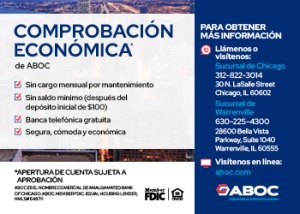Latest
-

-

-

-

-
 Triton College Launches PEPA Academy March 6, 2025
Triton College Launches PEPA Academy March 6, 2025
Popular
Tags
Artistas Adolescentes Aprenden el Valor de un Arduo Trabajo
Artists Nationwide
Brazilian Students Tour Kirie Water Reclamation Plant
Challenges of Returning to School in Adulthood
Chicago
Chicago Air and Water Show
Chicago CPS
Chicago Dream Act
Comparta su Historia
CPS
Cultura Latina
Delicious Salad Meals
Dream Act
Dream Act chicago
Dream Relief
Dream Relief Chicago
El Alma de la Fiesta
Ending Summer on the Right Foot
Ensaladas sencillas y deliciosas como plato principal
Estudiantes Brasileños Recorren la Planta de Reclamación de Agua Kirie
Feria de Regreso a la Escuela de la Rep. Berrios
Festival Unísono en Pilsen
Grant Park Spirit of Music Garden
ICIRR
ICIRR Receives Criticism Over Dream Relief Day
ICIRR Recibe Críticas
Jose Cuervo Tradicional
José Cuervo
José Cuervo Tradicional Celebra la Cultura Latina e Inspira Artistas a Nivel Nacional
Latin Culture
Los Retos de Volver a la Escuela Cuando Adultos
Meijer Abre sus Puertas en el Distrito de Berwyn
Meijer Opens in Berwyn District
orth side Summer Fest on Lincoln Ave
PepsiCo Foundation Apoya Futuros Periodistas Hispanos
PepsiCo Foundation Supports Future Hispanic Journalists
Share Your Story
Show Acuático y Aéreo
Simple
StoryCorps
storycorps.org
Teen Artists Learn the Value of Hard Work
Terminando el Verano con el Pie Derecho
Unisono Festival in Pilsen
‘El Chente’







The Influenza Pandemic
By Daniel Nardini
What kind of strain of influenza was it? That is still being argued today 100 years after the fact. Would penicillin have been able to stop this flu strain if penicillin was discovered over 20 years before? We will probably never know the answer. What we do know is that this influenza killed within a matters of days, filled the victims’ lungs with blue fluid that basically drowned them in their own lungs. The next question is could this happen again? Possible. The problem is that there are growing strains of flu which have become resistant to antibiotics. This means that dealing with new strains of flu might prove harder. What happened over 100 years ago is a cautionary tale of the possibility that while we may be far more advanced in terms of medicine than we were then, it is still possible that some virus could come about that might baffle science.